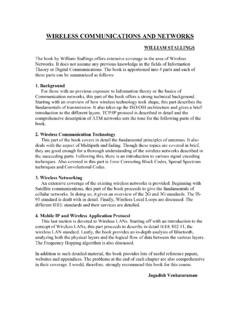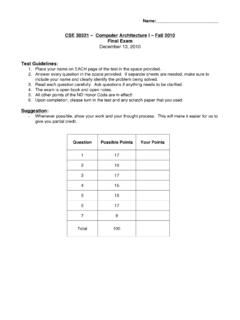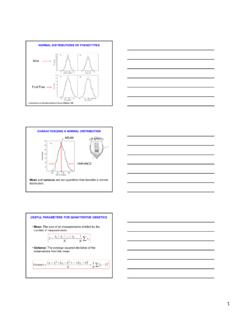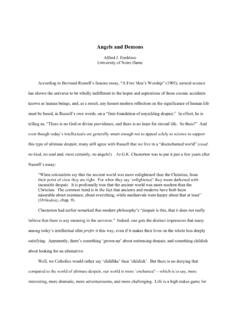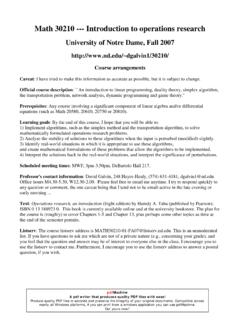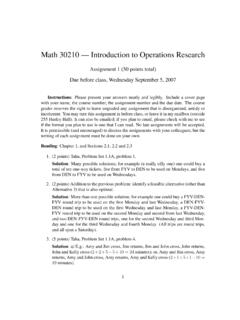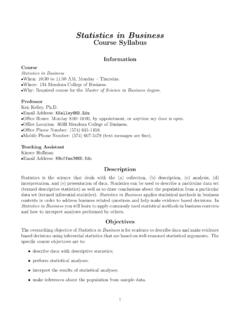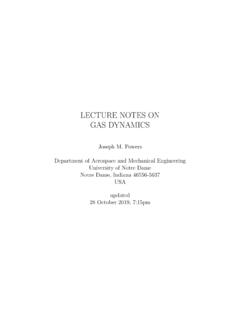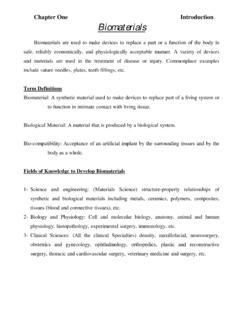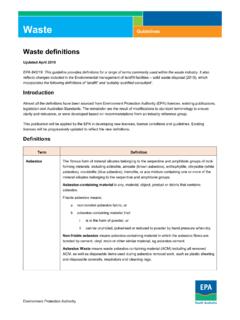Transcription of CHAPTER 3: CRYSTAL STRUCTURES
1 CRYSTAL Structure: Basic Definitions - lecture Calculation of material density self-prep. CRYSTAL Systems lecture + self-prep. Introduction to Crystallography lecture + self-prep. X-Ray Diffraction (XRD) lecture CHAPTER 3: CRYSTAL STRUCTURES atoms pack in periodic, 3D arrays typical of: Crystalline -metals -many ceramics -some polymers atoms have no periodic packing occurs for: Non-crystalline -complex STRUCTURES -rapid cooling crystalline SiO2 Non-crystalline SiO2 "Amorphous" = Non-crystalline MATERIALS AND PACKING Glass-Ceramics Quartz tubing is fabricated from beach sand The lamp applications are shown in the GE product montage Ceramics Crystals: atoms have long range periodic order Glasses (non-crystalline).
2 Atoms have short range order only (amorphous) Highly thermal resistive ceramics Low temperature (the ice cube) High temperature (the torch flame) Crystallography is the experimental science of the arrangement of atoms in solids. The word "crystallography" derives from the Greek words crystallon = cold drop / frozen drop, with its meaning extending to all solids with some degree of transparency, and grapho = write. A crystalline solid: HRTEM image of strontium titanate. Brighter atoms are Sr and darker are Ti. A TEM image of amorphous interlayer at the Ti/(001)Si interface in an as-deposited sample. CRYSTAL A CRYSTAL is any solid material in which the component atoms are arranged in a definite patter and whose surface regularity reflects its internal symmetry.
3 CRYSTAL FACES Unit Cell Unit cell is the smallest unit of volume that permits identical cells to be stacked together to fill all space. By repeating the pattern of the unit cell over and over in all directions, the entire CRYSTAL lattice can be constructed. Lattice points Atomic hard sphere model CRYSTAL Systems: Possible Unit Cell Shapes Goal is to Quantitatively Describe (a) Shape and Size of the Unit Cell (point symmetry) (b) Location of the Lattice Points (translational symmetry) What we will do ? For (a) to specify the CRYSTAL System and the Lattice Parameters For (b) to define the Bravais Lattice CRYSTAL Systems Different types (but not !!!!) of unit cell are possible, and they are classified based on their level of symmetry Unit cells need to be able to Stack them to fill all space !
4 ! This puts restrictions on Unit Cell Shapes Cubes Work! Pentagons Don t! Symmetry Do you know that there is only ONE object in the geometrical universe with perfect symmetry? It is a SPHERE!! Infinite planes of symmetry pass through its center, infinite rotational axes are present, and no matter how little or much you rotate it on any of its infinite number of axes, it appears the same! A sphere is the HOLY GRAIL of symmetry!! Symmetry is a the set of mathematical rules that describe the shape of an object CRYSTAL : Space Group By definition CRYSTAL is a periodic arrangement of repeating motifs ( atoms, ions). The symmetry of a periodic pattern of repeated motifs is the total set of symmetry operations allowed by that pattern Let us apply a rotation of 90 degrees about the center (point) of the pattern which is thought to be indefinitely extended.
5 This pattern will be unchanged as a result of this operation, the operation maps the pattern onto itself. Also a linear shift (translation) of this pattern by a certain amount ( by the length of a small square) results in that same pattern again. The total set of such symmetry operations, applicable to the pattern is the pattern's symmetry, and is mathematically described by a so-called Space Group The Space Group of a CRYSTAL describes the symmetry of that CRYSTAL , and as such it describes an important aspect of that CRYSTAL 's internal structure Translational Symmetry A Space Group includes two main types of symmetries ( symmetry operations) (I) The Translational Symmetries, and (II) The Point Symmetries Translations, executable shifting movements, proceeding along a straight line and on a certain specified distance, such that the operation does not result in any change of the shifted pattern.
6 Typically the translational symmetries are macroscopically not visible because the translation lengths are in the order of . High magnification structure image of the mineral Cordierite. The insert shows the idealized structure of Cordierite, as determined by X-ray diffraction techniques. ( Hurlbut & Klein, 1977, Manual of Mineralogy ) Point Symmetries It is a macroscopically visible symmetry operations: after it has been applied to the CRYSTAL at least one point remains where it was !! These operations are : Reflection in a point (inversion) Center of Symmetry! Reflection in a plane or Mirror Symmetry ! Rotation about an imaginary axis Rotational Symmetry! Rotation-and-after-it-inversion or Roto-inversion!
7 Center of Symmetry Example: The item, consists of two asymmetric faces: the every part of the item can also be found on the opposite side of some point (center of symmetry!!) at the same distance !! Reflection in a point or inversion! Mirror Symmetry A U V T YMirror PlaneverticalD E C BMirror PlanehorizontalH I OPeople and most vertebrates basically have mirror symmetry: in biology it is called bilateral symmetry Reflection symmetry in two directions Rotational Symmetry Figure looks the same n times in a 360 rotation. n-fold symmetry!! 6 6 / / / % / / / 99 two-fold symmetry Z S N three-fold symmetry four-fold symmetry six-fold symmetry One-fold symmetry = No symmetry!! A point around we rotate symmetry axis N-fold Roto-Inversion Symmetry The object will be transformed into itself after the following two step operation ( the 4-fold roto-inversion): a rotation of 90 degrees along the axis; followed by the inversion with respect to a point on the axis Objects may have more than one kind of symmetry Rotation Symmetry without Reflection Rotation Symmetry and Reflection O H I X Mirror planes in two direction + + two-fold rotation symmetry 4mm symmetry 3m symmetry The Sets of Basic Symmetry Elements for Crystals 1 fold rotation (rotation through 360 degrees); symbol: none 2 - fold rotation (rotation through 180 degrees).
8 Symbol: 2 3 - fold rotation (rotation through 120 degrees); symbol: 3 4- fold rotation (rotation through 90 degrees); symbol: 4 6- fold rotation (rotation through 60 degrees); symbol: 6 In the case of crystals the only above rotation axes can occur!! Mirror plane; symbol: m Center of Symmetry: p 4-fold roto-inversion axis unique element!; symbol: 4* CRYSTAL Classes With all these point symmetries ( Rotation, Reflection, and Roto-inversion) combinations can be made, which themselves are again cover operations, and this results in a total of 32 unique possibilities. Thus all crystals can be classified in 32 CRYSTAL SYMMETRY CLASSES according to their symmetry content, specific set of symmetry elements For example: The highest symmetrical Cubic (Hexakisohedric) Class possess the following symmetry elements: Three 4-fold rotation axes.
9 Four 3-fold rotation axes. Six 2-fold rotation axes. Three primary mirror planes. Six secondary mirror planes. Center of symmetry. The lowest symmetrical class Triclinic (Hemihedric) involves 1-fold rotation axis, thus no symmetry at all!! The CRYSTAL Systems In turn these symmetry classes, because some of them show similarities among each other, are divided among the different CRYSTAL Systems. There are six CRYSTAL System CUBIC (also called Isometric system) TETRAGONAL system HEXAGONAL system ORTHORHOMBIC system MONOCLINIC system TRICLINIC system Every CRYSTAL System involves a number of CRYSTAL Classes. Decreasing symmetry CRYSTALLOGRAPHIC AXES Refer to the axes in the order - a, b, c The point of intersection of the three axes is called the AXIAL CROSS.
10 By using these crystallographic axes we can define six large groups or CRYSTAL systems that all CRYSTAL forms may be placed in CUBIC (or ISOMETRIC) System -I The three crystallographic axes are all equal in length and intersect at right angles to each other. a = b = c a=b=g=90 Cube - is one of the easiest to recognize and many minerals display it with little modification: pyrite, fluorite, perovskite, or halite cubes! a1 a2 a3 .. In general this system involves 6 classes of symmetries and 15 CRYSTAL forms CUBIC (or ISOMETRIC)-II If you glance on the Hexoctahedron, which also belongs to this CRYSTAL system you will understand why CRYSTAL forms in the isometric system have the highest degree of SYMMETRY, when compared to all the other CRYSTAL systems.
